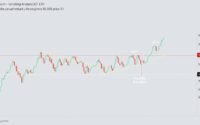4 Reasons Why Bitcoin’s Bull Run Is Intact Despite a Surprise Stop Hunt
Surprising fact: bitcoin recently traded only about 7% below its all‑time high, even after a sharp intraday wick to roughly $114,013 that wiped out over $200 million in long positions.
This quick shock tested support but did not break the larger trend. The market absorbed the liquidations and held structure, keeping BTC within single‑digit distance of the recent peak near $123,182–$124,495.
Derivatives and flow metrics point to caution, not capitulation. Monthly futures premium eased to ~6%, the lowest in four weeks, while options 25% delta skew sits near 5%, showing higher demand for downside hedges without panic.
Spot ETFs logged about $115 million in outflows after five days of inflows, a modest rebalancing move. Cross‑asset signals matter: BTC’s correlation with the S&P 500 climbed above 70% as Treasuries demand rose and job data softened.
Below we outline four firm reasons the broader uptrend remains intact and what investors should watch next. Read the full context and charts on this topic from a detailed report at the related analysis.
Key Takeaways
- Price action showed a short, sharp wick but stayed near recent highs, signaling resilience.
- Derivatives cool-off (6% futures premium, 5% delta skew) equals caution, not collapse.
- ETF flows were minor outflows after inflows—typical rebalancing, not systemic stress.
- Higher equity correlation reflects broad risk repricing amid mixed macro data.
- Overall setup points to continued bull momentum, with institutional hedging and policy tailwinds supportive.
Context: What the “surprise stop hunt” signals and where bitcoin price stands now
A sharp, short-lived drop triggered heavy liquidations without erasing the larger uptrend. The wick down to about $114,013 forced more than $200 million in long liquidations and shocked leveraged traders for a few hours. That fast move created a sentiment jolt but demand returned around clear support.
Monthly derivatives and ETF flows show caution, not collapse. Monthly futures basis sits near 6% and 25% delta skew is roughly 5%, a mix that points to measured hedging while holders keep exposure. Spot ETF flows flipped to about $115 million outflow in one day after several days of inflows — typical ebb and flow this month.
Recent pullback and trader impact
The rapid dip pulled price into the $112k–$114k support band where renewed demand surfaced. High-leverage traders bore the brunt, but higher lows on longer timeframes remain intact.
Why a sharp wick doesn’t mean a broken trend
- Local liquidity hunt: Intraday dips often clean stops near obvious levels rather than reverse a bull market.
- Measured hedging: Basis and skew suggest traders are cautious but willing to keep positions.
- Range to watch: Support at $112k–$114k and resistance near $123k–$125k frame short-term moves.
For recent technical reads and skews, see these recent BTC futures ideas.
Derivatives say caution, not capitulation: futures, options, and liquidations
Derivative signals show traders tightened risk controls after the wick, not a wholesale shift to bearish sentiment. The posture across futures, options, and liquidations supports a measured market response and keeps the bull setup intact.
Futures premium and what 6% means
The two-month annualized futures premium sits near 6%, a four-week low. That level signals softer appetite for leverage but still positive demand. A sustained negative basis or zero premium would be a clearer sign of a bear market. Here, the basis supports constructive positioning.
Options skew: hedging, not panic
The 25% delta put-call skew trades around 5%. This modest skew fits rational hedging after volatility. It shows options pricing reflects caution, not the extreme fear that precedes major capitulation.
Liquidations and support confidence
Roughly $200M in long liquidations hit during the wick to ~$114k. Those losses trimmed fragile positions and often reset books for healthier trading volume afterward. Traders are watching the $112k–$114k support level for demand absorption and the $123k–$125k band as resistance.
| Metric | Value | Interpretation | Impact |
|---|---|---|---|
| Two‑month futures premium | ~6% | Softer leverage demand | Constructive, not bearish |
| 25% delta skew | ~5% | Modest put demand | Risk management |
| Long liquidations | $200M+ | Stop flush | Reduces fragility |
| Spot flows (single day) | ~$115M outflow | Rebalancing after inflows | No systemic stress |
Flows and macro: ETF dynamics, correlation with stocks, and Treasury yields
Short-lived ETF outflows came amid stronger Treasury bids, signaling cross‑market positioning more than panic. Spot bitcoin ETFs posted roughly $115 million in net outflows on a recent Thursday after five straight days of inflows. That daily swing looks like rebalancing, not structural stress in the market.
Spot ETF behavior and participation
Day-to-day ETF variability is common. Brief outflows after inflows often reflect profit-taking by some investors while others stay allocated.
Trading volume and cycle breadth
Trading volume across major crypto venues remains below the peaks of 2017 and 2021. This leaves room for participation to expand if the rally broadens to more assets in coming months and years.
Correlation and Treasury demand
BTC’s 40-day correlation to the S&P 500 rose above 70%, so bitcoin has behaved more like higher‑beta tech in recent swings. At the same time, demand for the 1‑year U.S. Treasury hit a three‑month high as labor data and inflation views nudged rate expectations lower.
- Takeaway: ETF flow swings + rising Treasury interest suggest rotation across assets, not a crypto sell-off.
- Watch: whether trading volume and broader participation rebuild—this historically supports durable cycles.
Technicals favor continuation: bullish flag, key levels, and invalidation
Price action on the daily chart forms a classic bullish flag, with a sharp vertical advance followed by a tight, descending channel. This structure often leads to continuation when the lower boundary holds near prior highs.

Bullish flag tests prior high as support
The descending channel has pulled prices back to test the $112,207–$114,000 zone. That cluster acts as a strong support level because prior resistance often flips to bids.
Levels that matter
Key short-term levels are clear: keep an eye on $112k–$114k as support and $123k–$125k as resistance. A successful hold typically points toward a measured move up into the upper band.
Invalidation and risk
A decisive break below ~$110,000 would invalidate the immediate bullish case and raise the odds of a deeper retracement. Traders should use that level for risk management if they lean long.
- Upside objective: retest of $123k–$125k on flag breakout and measured move logic.
- Bear market signal: sustained price action below $110k would shift the setup toward vulnerability.
- Volume note: the pullback lacked distribution-style volume, suggesting a shakeout rather than topping.
4-reasons-why-bitcoins-bull-run-is-intact-despite-a-surprise-stop-hunt
Policy shifts and growing institutional access are reshaping how capital flows into bitcoin, strengthening the broader uptrend. Below are four concrete reasons the crypto bull run still has momentum.
Institutional and regulatory tailwinds
Spot ETFs and federal moves like the GENIUS Act open wider channels for institutional investment. That permits larger mandates and deeper liquidity.
Result: smoother inflows from funds, corporates, and retirement vehicles that support sustained demand.
Cycle outlook
Analysts at Bernstein map a path to roughly $200,000 within 6–12 months, while other credible views see peaks near $140k–$150k this cycle.
Takeaway: multiple plausible scenarios point toward a constructive period rather than immediate reversal.
Post-shock resilience
Bitcoin has rebounded after past shocks—FTX, policy headlines, and macro surprises—with demand returning and prices renewing highs.
This pattern shows the market often heals quickly in a bull market season.
Market structure and participation
Price action still posts higher lows near $112k–$114k with neutral‑to‑constructive derivatives and brief ETF outflows.
Combined with diverse investor types, this structure reduces fragility and supports continued upside, provided key support holds.
| Reason | Driver | Implication |
|---|---|---|
| Institutional tailwinds | ETFs, GENIUS Act, policy initiatives | Deeper liquidity, larger mandates |
| Cycle scenarios | Bernstein $200k vs conservative $140k–$150k | Multiple constructive paths for prices |
| Post‑shock rebound | Historical recoveries after FTX, headlines | Quicker demand restoration |
| Market structure | Higher lows, diversified investors | Lower fragility, sustained demand |
Conclusion
Across on-chain, derivatives, and ETF flows, the picture reads as consolidation rather than a regime shift.
Bitcoin remains roughly 7% below its all‑time high after a brief wash to about $114k. Futures basis near 6% and a 25% skew around 5% point to caution, not capitulation.
The market shows higher lows near $112k–$114k and faces supply near $123k–$125k. A break under ~$110k would flip the setup toward a bear market view.
Views range from a months‑long advance toward higher targets to a nearer‑term peak, yet current structure still reads bull. ETF participation and institutional flows may dampen extremes even as crypto prices stay volatile.
Not investment or tax advice: this is an informational synthesis for U.S. readers. Monitor trading activity, macro catalysts, and the $112k–$114k support band in the coming weeks.
FAQ
What does the "surprise stop hunt" mean for bitcoin prices?
A surprise stop hunt is a short, sharp move that triggers leveraged stop-loss orders and forces liquidations. It often shows up as a deep wick on the chart. In bitcoin’s case, the event created short-term selling pressure and liquidations but did not destroy the broader demand structure or long-term trend.
Did the pullback break the bull market trend?
No. The pullback tested lower support levels and shook leveraged positions, yet price behavior and volume patterns point to a corrective move rather than a trend reversal. Key support ranges remained intact, signaling that the bull market is still intact unless price decisively closes below invalidation levels.
How much did futures and options activity change after the stop hunt?
Futures premium moved toward roughly 6%, indicating softer risk appetite but not a full collapse. Options skew tightened to a neutral-to-bearish bias at the 25% delta, reflecting caution rather than panic. These derivatives shifts suggest traders adjusted positions without abandoning bullish frameworks.
Were liquidations significant enough to mark a turning point?
Over 0 million in long liquidations occurred, which is large for a single event but typical for stop hunts in leveraged markets. Such liquidations amplify short-term volatility but do not automatically equal a bear-market flip when underlying demand and flows remain supportive.
Which price levels are traders watching now?
Traders are watching support around 2k–4k and resistance near 3k–5k. A sustained drop below about 0k would be the key invalidation level for this bullish thesis. Until that break, the pattern favors continuation.
How did spot bitcoin ETF flows react, and does that matter?
Spot ETF flows showed a short outflow after a period of steady inflows. This suggests temporary rebalancing rather than systemic stress. ETF demand remains an important institutional channel, and net inflows over time would reinforce the bull case.
What role do macro factors like stocks and Treasury yields play today?
Correlation with the S&P 500 has risen, so equity risk sentiment affects bitcoin more than in prior cycles. Strong demand for 1-year Treasuries points to rate sensitivity across markets. These macro links can amplify moves but don’t negate crypto-specific drivers like ETF adoption and network fundamentals.
Which technical patterns support a continuation of the rally?
Technicals show a bullish flag formation near prior highs acting as support within the current range. Higher lows and constructive volume on rebounds support the idea of continuation rather than distribution.
What institutional and regulatory tailwinds are supporting bitcoin?
Institutional adoption via spot ETFs, clearer regulatory frameworks, and legislative proposals that favor digital-asset market access are bolstering long-term demand. These factors attract larger pools of capital and diversify investor participation.
How should investors interpret price shocks in the context of the cycle outlook?
Investors should view shocks as volatility within a bullish cycle when structural demand and key supports hold. Analysts have varied targets—some see higher mid-term price paths—so risk management and position sizing remain essential.
Can historical rebound patterns after shocks guide expectations now?
Yes. Past episodes show that sharp liquidations and sentiment shocks often precede recoveries when buying interest returns. History isn’t a guarantee, but it offers a reasonable template for resilience if fundamentals and flows recover.
What would invalidate the bullish case in the near term?
A decisive, sustained close below the 0k area, combined with collapsing ETF demand and widening derivatives stress, would undermine the current bullish thesis. Until then, the structure favors continuation with higher risk management vigilance.


